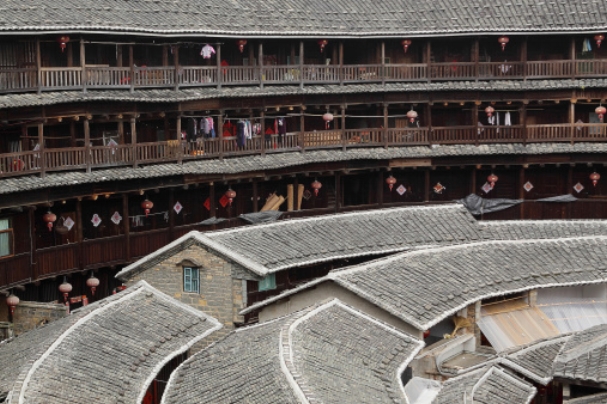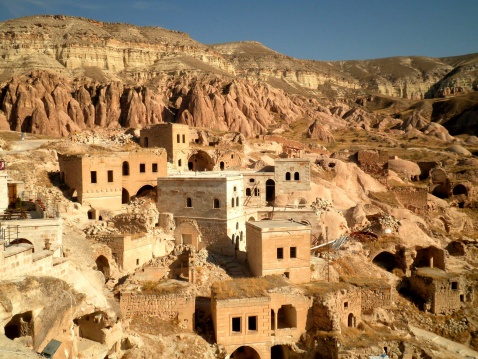Houses around the world are built of different materials.
Materials can be natural or made by people.
Natural materials are mud, stones, trees and other plants.
Bricks, cement, and metal are materials made by people.
Houses of nomadic people
A tent house of nomadic people of Tunisia. Getty Images
In earlier times people didn't build houses. They lived in caves. Some travelled, carrying tents with them. The tents were made of the skins of animals and were easy to move and light to carry. People who moved from place to place were known as nomadic people.
Some examples of how people in different parts of the world built houses using materials easily obtained in those places. Some of these traditional houses are in use today.
A yurt is a portable house used in Mongolia. Getty Images
Houses of wood and felt: Yurts or Gers
Today in Mongolia, and other parts of Central Asia, the people who live as herders of sheep and horses, shelter in yurts (or gers) which are portable, folding homes. Families can follow their animals as they move to different pastures.
To the Mongolians, the word yurt means 'home'. They set up their yurts in places where water is easy to get, and where there is grass for their horses and sheep. The yurt has a light wooden frame over which a felt cover, made from sheep's wool, is stretched. The felt gives protection from the weather and insulates against cold and heat.
More permanent houses
About 10 000 years ago people began to build houses. The type of house they built and the materials they used depended on where they lived. If it was in a cold place they built a house with a place for a fire inside. There was usually only one room in the house and the fire was placed in the centre of the room. A hole in the roof let the smoke escape. Chimneys weren't invented yet.
Materials used might have included wood, other plants and animal skins. The roof would be thatched (made of plants) or wooden tiles called shingles. The roof would slope so that rain and snow would slide off. The floor of the house was just the ground. The animals kept by the people shared the house or were kept in a second room nearby.
Houses of mud and timber: Tulou
Since the 1300s people In the province of Fujian in China have lived in large groups, inside the high mud walls of a tulou.
Apartments are built around the inside wall of the tulou. Getty Images
Tulou means 'earth building'. Inside there can be up to 250 identical rooms or apartments built around a courtyard. The building are made of wood, including the tiles on the roof. In the courtyard people can cook, wash and dry clothes and children can play. Families also gather there for celebrations.
At first, the tulou were built as safe places that protected the people from raiding bandits.
Watch a video about tulou in the Fujian province of China where people still live as they did hundreds of years ago:
Tata houses in Togo and Benin, West Africa
In hot places, and where there wasn't much wood, people made mud bricks and build a house with them. The roof was flat and people could sleep safely there on hot nights. Sometimes several houses were built inside a walled courtyard and the animals would be kept in the yard.
Tata house: Another kind of fortress house. Image from http://mmb.cryst.bbk.ac.uk/homepages/ubcg60a/ghana/art.html
Today, the Tammari people in Togo and Benin, in West Africa, Tata houses are built with wood, handmade mid bricks and straw. There are usually five rooms inside and each has two storeys.
Goats, sheep, and guinea fowl live on the ground floor where there is also a place for cooking. Spirits of the living and dead are also believed to live on the ground floor. There is a small tunnel from the room where animals are kept at night, leading to the chicken coop. The chickens bring themselves inside at night to join the other animals in a place safe from predators and thieves.
Mud and straw are also used to build huts like this in Ghana, Africa. Getty Images
The top floor, open to the sky, is where people sleep, and in times past, watched for enemies. The towers of the Tata, with thatched straw roofs, are used to store grain.
Read more about tata houses and see photos of them inside and out
https://www.youngpioneertours.com/tata-houses-togo-benin/
Houses of bamboo and grass: Tongkonan
The boat shape is a symbol of the way the people travelled to Indonesia from China, long ago. Getty Images
These houses in a traditional Torajan village on Sulawesi, Indonesia are made from timber, bamboo and grass. The wooden houses are built off the ground on stilts and have wooden floors. The walls are highly decorated with carvings of plants and buffalo. traditionally the tongkonan had thatched roofs, but those built today usually have roofs made of sheets of iron.
Houses of ice and snow
Cutting blocks of snow to build an igloo in the 1800s. © Getty Images
Igloos were built by the indigenous people of the Arctic region of Canada and Greenland.
The term ‘eskimo’ was a term used for all indigenous peoples of the Arctic. However, they prefer to be known by names in their own languages: ‘inuit’ by the peoples of Canada, Alaska and other groups; ‘Greenlander’ or ‘Kalaallisut’ by the people of Greenland.
An igloo is also called a snow house or a snow hut. An igloo is often a temporary shelter built during a hunting trip. Larger igloos were built for families.
The Inuit also built houses with whale bones and animal hides. They used snow to insulate their houses, because air pockets trapped in the snow helped keep out the cold.
Watch a video to find out why and how you stay warm and cosy in an igloo!
https://www.youtube.com/watch?v=1L7EI0vKVuU
Houses of rock and stone in central Turkey
The soft rock in Cappodocia makes it easier to carve a place for a house. © Getty Images
Thousands of years ago people carved houses out of the soft rock in the Göreme Valley, of Cappadocia,Turkey. The site is protected and is a World Heritage Site.
Read about the houses in Cappodocia and see photographs:
It’s a good idea to find information from more than one source!
Watch a video on amazing traditional houses from around the world, and some modern versions based on the traditional
https://www.youtube.com/watch?v=bEZ9Gj4ymEk
Read more about some traditional houses around the world, many of them built just as people’s ancestors built them
https://www.compassionuk.org/blogs/25-different-types-of-houses-from-around-the-world/
https://travel.earth/delightful-traditional-houses-around-the-world/
Read more and see photographs of some very unusual houses around the world - these ones aren’t traditional!
https://www.boredpanda.com/unusual-homes/?utm_source=google&utm_medium=organic&utm_campaign=organic









